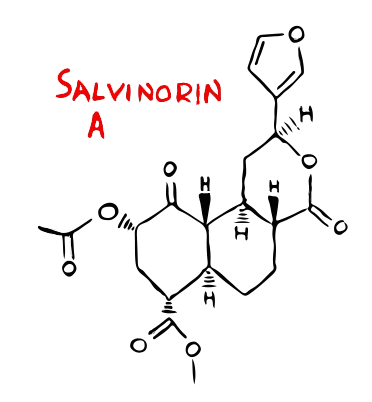Salvia divinorum is a psychoactive plant that has been cultivated for hundreds of years by the Mazatec tribe of Oaxaca, Mexico. The Mazatec Indians revered its powerful properties, chewing the plant in healing rituals to induce religious experiences. It’s been given various names by the tribe – Ska Maria, Ska Pastora, Yerba de Maria – names all strongly influenced by Christianity.

Salvia’s many names are associated with Christianity’s Virgin Mary
Several anthropologists and ethnobotanists visited the Mazatec tribes from the 1930s onwards, but the plant was revered to such an extent it was impossible to see the Salvia rituals, let alone get hold of the plant. In the late 60s, Gordon Wasson and the famous Albert Hoffman (creator of LSD) went searching for a sample of Salvia and introduced it to the western world.
Salvia contains the world’s most potent naturally occurring psychoactive compound, Salvinorin A. This molecule has been investigated thoroughly and has potential in various aspects of medical research. Salvinorin A activates a unique receptor, the kappa-opioid receptor, which is not activated by any other natural psychedelics.

Salvinorin A is unlike any other natural psychoactive compound
Although the Mazatecs typically ingest Salvia by chewing the fresh leaves or brewing tea, current recreational use mainly consists of smoking concentrated extracts. This means the effects of Salvia when taken recreationally can be stronger than those experienced in traditional healing rituals. Users typically experience derealisation, visual hallucinations, altered body perception and confusion. When smoked, the effects of Salvia last only a few minutes. When taken traditionally, as chewed leaves or a tea, the effects may be weaker but last for hours.

Traditional Mazatec healing ritual. Photo from Discover magazine.
There is currently no evidence to suggest that Salvia is toxic or has long-term psychological effects, however all psychedelic drugs should be treated with respect. Its legality varies from country to country.
Useful links:
Blog posts about Salvia on The Psychedelic Scientist
Compendium of Salvia experiences
Community for Salvia enthusiasts
References:
Marushia R (2002) Salvia divinorum: the botany, ethnobotany, biochemistry and future of a Mexican mint. BPSC Ethnobotany.
Roth BL, Baner K, Westkaemper R, Siebert D, Rice KC, Steinberg S, Ernsberger P & Rothman RB (2002) Salvinorin A: a potent naturally occurring nonnitrogenous kappa-opioid selective agonist. PNAS 99(18):11934-11939
Siebert DJ (1994) Salvia divinorum and Salvinorin A: new pharmacologic findings. J Ethnopharmacology 43, 53-56.